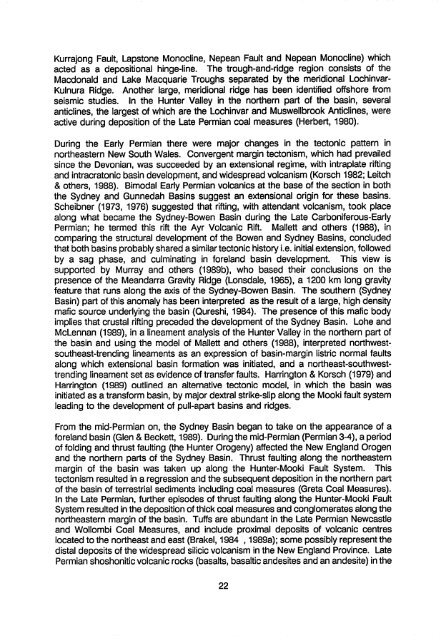II II II II II - Geoscience Australia
II II II II II - Geoscience Australia
II II II II II - Geoscience Australia
Create successful ePaper yourself
Turn your PDF publications into a flip-book with our unique Google optimized e-Paper software.
Kurrajong Fault, Lapstone Monocline, Nepean Fault and Nepean Monocline) which<br />
acted as a depositional hinge-line. The trough-and-ridge region consists of the<br />
Macdonald and Lake Macquarie Troughs separated by the meridional Lochinvar-<br />
Kulnura Ridge. Another large, meridional ridge has been identified offshore from<br />
seismic studies. In the Hunter Valley in the northern part of the basin, several<br />
anticlines, the largest of which are the Lochinvar and Muswellbrook Anticlines, were<br />
active during deposition of the Late Permian coal measures (Herbert, 1980).<br />
During the Early Permian there were major changes in the tectonic pattern in<br />
northeastern New South Wales. Convergent margin tectonism, which had prevailed<br />
since the Devonian, was succeeded by an extensional regime, with intraplate rifting<br />
and intracratonic basin development, and widespread volcanism (Korsch 1982; Leitch<br />
& others, 1988). Bimodal Early Permian volcanics at the base of the section in both<br />
the Sydney and Gunnedah Basins suggest an extensional origin for these basins.<br />
Scheibner (1973, 1976) suggested that rifting, with attendant volcanism, took place<br />
along what became the Sydney-Bowen Basin during the Late Carboniferous-Early<br />
Permian; he termed this rift the Ayr Volcanic Rift. Ma!lett and others (1988), in<br />
comparing the structural development of the Bowen and Sydney Basins, concluded<br />
that both basins probably shared a similar tectonic history i.e. initial extension, followed<br />
by a sag phase, and culminating in foreland basin development. This view is<br />
supported by Murray and others (1989b), who based their conclusions on the<br />
presence of the Meandarra Gravity Ridge (Lonsdale, 1965), a 1200 km long gravity<br />
feature that runs along the axis of the Sydney-Bowen Basin. The southern (Sydney<br />
Basin) part of this anomaly has been interpreted as the result of a large, high density<br />
mafic source underlying the basin (Qureshi, 1984). The presence of this mafic body<br />
implies that crustal rifting preceded the development of the Sydney Basin. Lohe and<br />
McLennan (1989), in a lineament analysis of the Hunter Valley in the northern part of<br />
the basin and using the model of Mallett and others (1988), interpreted northwestsoutheast-trending<br />
lineaments as an expression of basin-margin listric normal faults<br />
along which extensional basin formation was initiated, and a northeast-southwesttrending<br />
lineament set as evidence of transfer faults. Harrington & Korsch (1979) and<br />
Harrington (1989) outlined an alternative tectonic model, in which the basin was<br />
initiated as a transform basin, by major dextral strike-slip along the Mooki fault system<br />
leading to the development of pull-apart basins and ridges.<br />
From the mid-Permian on, the Sydney Basin began to take on the appearance of a<br />
foreland basin (Glen & Beckett, 1989). During the mid-Permian (Permian 3-4), a period<br />
of folding and thrust faulting (the Hunter Orogeny) affected the New England Orogen<br />
and the northern parts of the Sydney Basin. Thrust faulting along the northeastern<br />
margin of the basin was taken up along the Hunter-Mooki Fault System. This<br />
tectonism resulted in a regression and the subsequent deposition in the northern part<br />
of the basin of terrestrial sediments including coal measures (Greta Coal Measures).<br />
In the Late Permian, further episodes of thrust faulting along the Hunter-Mooki Fault<br />
System resulted in the deposition of thick coal measures and conglomerates along the<br />
northeastern margin of the basin. Tuffs are abundant in the Late Permian Newcastle<br />
and Wo!Iambi Coal Measures, and include proximal deposits of volcanic centres<br />
located to the northeast and east (Brake!, 1984 , 1989a); some possibly represent the<br />
distal deposits of the widespread silicic volcanism in the New England Province. Late<br />
Permian shoshonitic volcanic rocks (basalts, basaltic andesites and an andesite) in the<br />
22

















